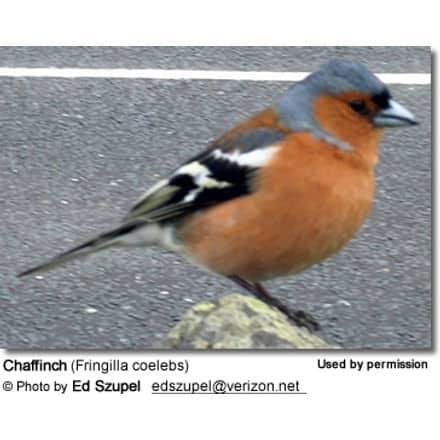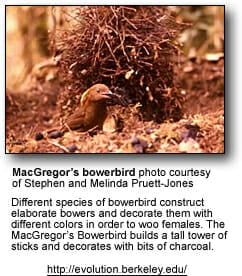Chaffinches (Fringilla coelebs)
The Chaffinches (Fringilla coelebs) is a small finch (family Fringillidae) that is widespread and common throughout Europe. Its range extends into western Asia, northwestern Africa, the Canary Islands, and Madeira.
The Chaffinch is resident in the milder parts of its range, but migrates south, away from the colder regions, in winter.
Finch Data: Range, Length, Clutch-size and Incubation Periods for each Finch Species

Recognized Subspecies and Ranges
- Fringilla coelebs madeirensis: Range: Madeira
- Fringilla coelebs africana: Rane: North Africa
- Fringilla coelebs tintillon: Range: Canary Islands
Description
The Chaffinches averages 14 to 16 cm in length (including tail). They have large double white wing bars, white tail edges, and greenish rump.
The breeding male is reddish below and has a grey cap.
The female is duller and greener.
Species Research by Sibylle Johnson
The below information is courtesy of Mandy and Paul – Breeder of Canaries and Other Exotic Birds – Singing Wings Aviary – www.singing-wings-aviary.com (A great source for these beautiful little finches)
Diet:
In the wild, Chaffinches eats a variety of seeds and plant material. The chicks are fed extensively on insects.
A good Chaffinch diet should consist of mixed millets with Canary grass seed, wild songbird seeds, and green food. Fresh water, cuttlebone, and grit should also be supplied at all times. Wild seed heads, Lettuce, Spinach, Chickweed, spray millet, Eggfood, Brocolli tops, and Carrot tops can also be offered on a regular basis.
General Care:
Generally a hardy species but shy, provide bath water daily!
Compatibility:
This species is best kept as single pairs or one male to several hens.
Housing:
Chaffinches are a slightly nervous species and they do not thrive well in small cages. They do best as a pair in a planted aviary with coverage to help them feel more secure.
Some heat will be required during winter months if not acclimated to colder weather so these birds are best suited for large indoor aviaries during winter.
In the summer time they will thrive and come into best condition in outdoor aviaries provided you provide shelter to keep them from damp conditions.
Song:
Chaffinch males have a pleasing song with variation. Calls can also be heard from the male as well as hens.
Its call is described as ” fink or vink” … Males typically sing two or three different song types. Regional dialects have also been noted.
Breeding:
Though not very willing breeders in captivity without privacy and livefood wild flocks are abundant in the UK. During the breeding season (which is normally April) canary shaped nests are built from feathers, moss, grass, wool, lichen, and small stripes of bark.
The eggs are similar to Canary or Greenfinch eggs beginning light blue with brown splotches with 5 eggs to an average clutch. The hen incubates the eggs for 14-16 days.
After hatching both males and females will feed the chicks mainly on live food, germinated seeds, and green food. Chicks normally fledge 18-21 days after hatching and are weaned around 35 days old. Young birds resemble hens.
Wild Chaffinches build their nests in tree forks, decorating the exterior with moss or lichen for camouflage. The typical nest contains, on average, six eggs.
Further Finch Reading
- Finch Information
- Index of Finch Species
- Photos of the Different Finch Species for Identification
- Common Health Problems of Finches
- Finch / Canary Diet / Nutrition





